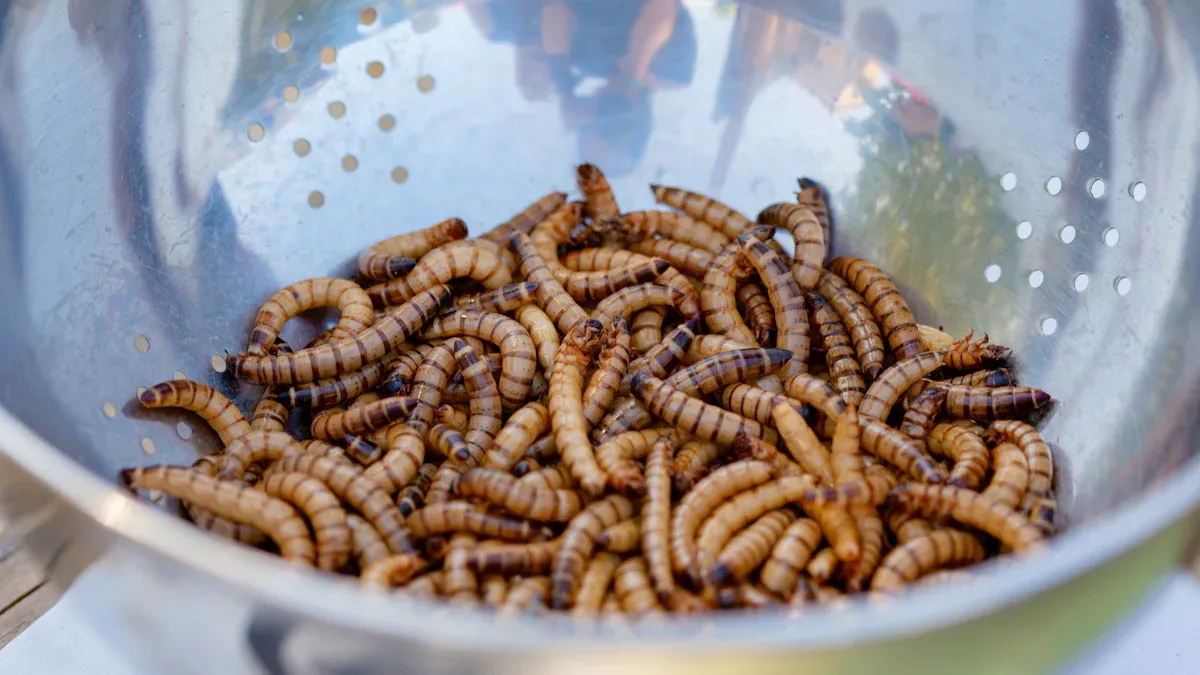
Mealworms are the larvae of darkling beetles, and they’ve become a favorite treat for many bird species. Their high protein content makes them a nutritious addition to a bird’s diet. Bird enthusiasts love offering mealworms because they attract a variety of feathered visitors. Studies have shown that mealworms can improve bird health by boosting their energy levels and supporting better digestion. Mealworms on bird feeding habits have created a positive shift, encouraging birds to thrive in different environments.
Key Takeaways
- Mealworms are healthy for birds. They give protein and nutrients. These help birds stay strong and full of energy.
- Giving mealworms with seeds and fruits keeps birds healthy. It also stops them from depending on just one type of food.
- Live and dried mealworms are both good. Dried ones are easy to keep and use, so they are handy for bird lovers.
Are Mealworms Safe and Beneficial for Birds?
Common Misconceptions About Mealworms on Bird Feeding Habits
Some bird enthusiasts hesitate to offer mealworms, believing they might harm birds or disrupt their natural feeding habits. However, these concerns are largely unfounded. Mealworms are recognized as a protein-rich treat that supports bird health. Specific species, like robins, are particularly drawn to them, making mealworms an excellent choice for attracting birds to your yard. Contrary to the belief that mealworms might make birds overly dependent, they actually encourage natural foraging behaviors. This helps birds stay active and engaged while benefiting from a nutritious food source.
Tip: If you’re looking to attract a variety of birds, try offering dried mealworms. They’re easier to handle and just as nutritious as live ones!
Why Mealworms Are a Natural and Safe Food Option
Mealworms are a natural part of many birds’ diets in the wild. They are rich in crude protein (about 50%) and contain essential amino acids, fatty acids, and minerals like zinc and magnesium. These nutrients are vital for birds’ growth, energy, and overall health. Studies show that mealworms, when sourced from well-managed environments, pose minimal health risks. Research on endoparasites in live feed confirms that mealworms are safe for birds, provided they come from reputable suppliers.
Here’s a quick look at their nutritional profile:
- Protein: Essential for egg-laying and feather regrowth.
- Chitin: Improves gut health by reducing harmful bacteria.
- Vitamins: Boosts immunity and energy levels.
- Fatty Acids: Supports healthy skin and feathers.
Dried mealworms are particularly convenient. They offer all the benefits of live mealworms without the wriggle, making them a favorite among bird enthusiasts who prefer less handling.
Addressing Concerns About Overfeeding Mealworms
Overfeeding is a common worry, but moderation is key. Mealworms should complement a bird’s diet, not replace it. Birds thrive on variety, so offering mealworms alongside seeds, fruits, and other natural foods ensures balanced nutrition. A study comparing health metrics of birds fed mealworms versus alternative diets highlights this balance:
| Metric | Mealworm Diet (Mean) | Alternative Diet (Mean) |
|---|---|---|
| Feed intake (g/d) | 160.8 | 159.2 |
| Feed conversion ratio | 1.82 | 1.70 |
| Live weight (g) | 2873.4 | 2975.9 |
| Carcass weight (g) | 2020.8 | 2163.3 |
| Dressing (CW/LW %) | 70.34 | 72.71 |
| Breast (% CW) | 34.04 | 34.50 |
| Fat (% CW) | 2.00 | 2.04 |
| Heart (% CW) | 1.56 | 1.30 |
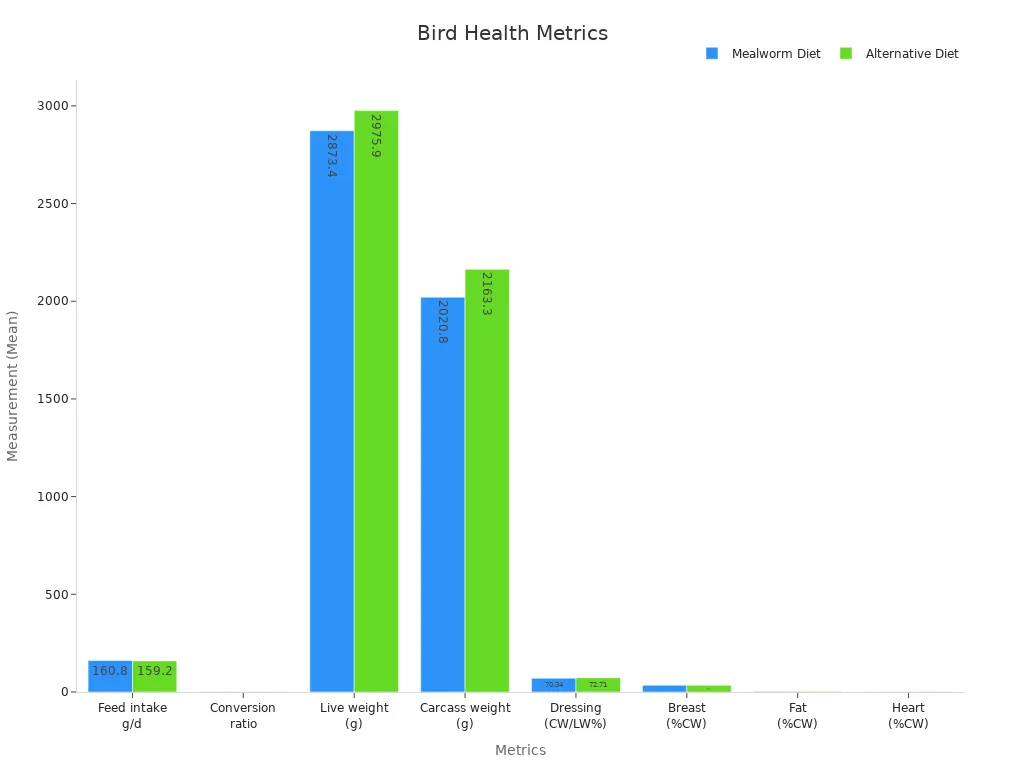
This data shows that while mealworms are a nutritious addition, they should be part of a diverse diet. Feeding birds responsibly ensures they get the best of both worlds—nutrition and variety.
Nutritional Value of Mealworms
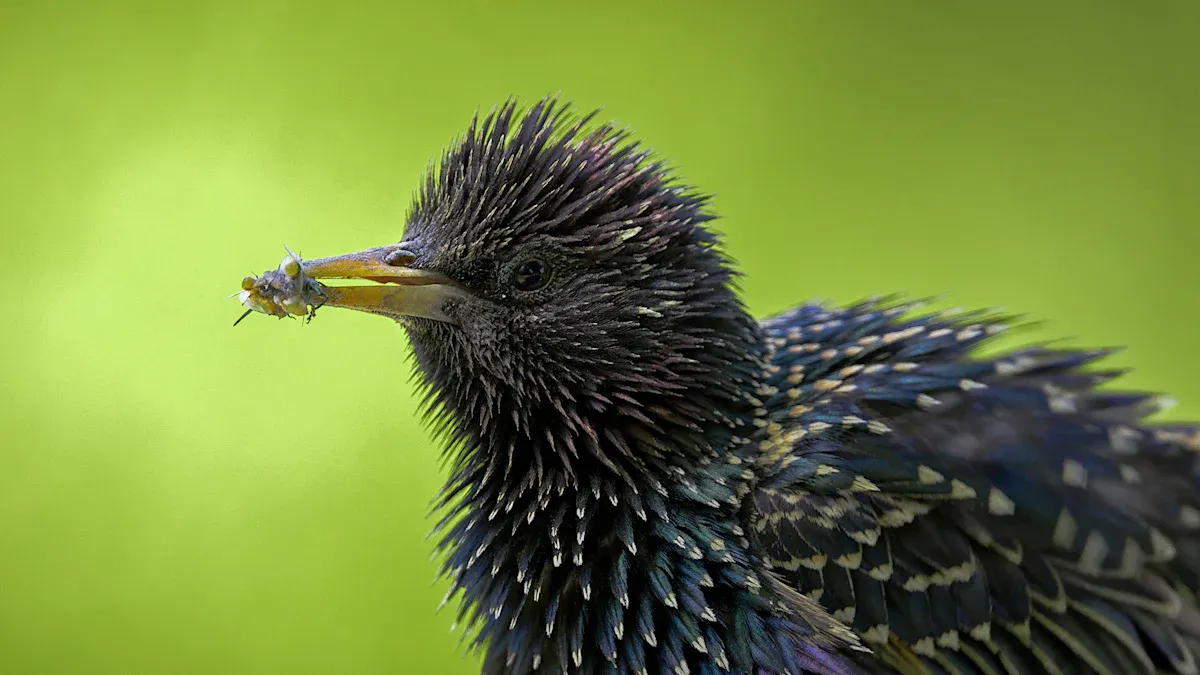
Key Nutrients in Mealworms and Their Benefits for Birds
Mealworms pack a punch when it comes to nutrition. They’re loaded with protein, fats, and essential micronutrients that birds need to thrive. Protein, which makes up about 50% of mealworms, helps birds build muscle and repair tissues. Fats provide the energy birds need for activities like flying and foraging. Micronutrients, including minerals like calcium and zinc, contribute to healthy feathers and overall physiological health.
Here’s a quick breakdown of their nutritional profile:
| Nutrient Component | Percentage | Benefits for Birds |
|---|---|---|
| Protein | 50% | Supports muscle development and tissue repair |
| Fats | 30% | Provides high-energy sustenance |
| Micronutrients | N/A | Promotes feather growth and physiological health |
| Digestibility | N/A | Ensures efficient nutrient absorption |
| Hydration | N/A | Maintains hydration levels |
Mealworms on bird feeding habits have proven to be a game-changer, offering birds the nutrients they need to stay active and healthy.
Comparing Live Mealworms vs. Dried Mealworms
Live and dried mealworms each have their perks. Live mealworms are rich in moisture, making them a great hydration source for birds. They’re especially beneficial during nesting and migration seasons when birds need extra energy. On the other hand, dried mealworms retain much of their nutritional value, including high protein and fat content. They’re easier to store and handle, making them a convenient option for bird enthusiasts.
-
Live Mealworms:
- Provide hydration due to their moisture content.
- Help birds gain weight and improve overall health.
- Ideal for birds during high-energy periods like migration.
-
Dried Mealworms:
- Offer concentrated nutrients, including over 50% protein.
- Can replace up to 100% of soybean meal in bird diets.
- Perfect for those who prefer less handling and longer storage.
Both options support birds’ energy needs, but dried mealworms are a healthier alternative to feeding bread at local duck ponds.
How Mealworms Support Bird Health and Energy Needs
Mealworms do more than just fill a bird’s belly—they actively improve health and energy levels. Studies show that even small amounts of mealworms in a bird’s diet can enhance gut health and nutrient absorption. For example, research on broiler chickens found that mealworms positively impacted intestinal health and microbiota composition. This means birds digest their food better and get more energy from their meals.
Mealworms also help birds stay active. Their high protein and fat content fuel metabolic demands, while their digestibility ensures birds get the most out of every bite. Whether it’s a robin hopping around your garden or a duck at the pond, mealworms provide the energy they need to thrive.
Tip: Offering mealworms responsibly as part of a varied diet ensures birds get balanced nutrition without over-reliance on a single food source.
Mealworms on Bird Feeding Habits
The Role of Protein in Bird Diets
Protein plays a crucial role in a bird’s diet. It helps with muscle development, feather growth, and overall energy. Birds, especially during breeding or molting seasons, need protein-rich foods to stay healthy. Mealworms are an excellent source of protein, providing about 50% of their nutritional content in the form of this essential nutrient. Studies have shown that mealworm-based diets, such as those using Tenebrio molitor, offer high amino acid digestibility (AID), making them an efficient protein source for birds.
| Study | Findings | Protein Source |
|---|---|---|
| Johnson et al. (1998) | Evaluated mealworm-based ingredients using cecectomized rooster assay | A. diaperinus, T. molitor |
| Yoo et al. (2019) | High AA AID and SID in T. molitor-based diet for growing pigs | T. molitor |
| Ji et al. (2016) | High AA AID for T. molitor-based diet in early-weaned pigs | T. molitor |
This data highlights the nutritional value of mealworms and their ability to meet birds’ protein needs effectively.
Seasonal Considerations for Feeding Mealworms
Birds’ feeding habits change with the seasons. During breeding seasons, they require more protein to support egg-laying and chick development. Mealworms become a valuable food source during this time. In migration periods, birds need high-energy foods to fuel their long journeys. Mealworms, rich in protein and fats, provide the perfect boost. However, in nonbreeding seasons, birds may rely less on mealworms due to reduced energy demands.
| Study Title | Key Findings | Seasonal Context |
|---|---|---|
| Food availability limits avian reproduction in the city | Mealworm provisioning rates impact feeding behavior during breeding seasons. | Breeding season |
| The amount of available food affects diurnal locomotor activity in migratory songbirds during stopover | Mealworms influence feeding behavior and activity levels during migration. | Migration periods |
Providing mealworms during these critical times ensures birds get the nutrition they need when they need it most.
Addressing Concerns About Dependency on Mealworms
Some worry that birds might become dependent on mealworms. However, birds are natural foragers and will continue to seek out other food sources. Offering mealworms as part of a varied diet encourages balanced nutrition. By combining mealworms with seeds, fruits, and other natural foods, bird enthusiasts can ensure their feathered visitors remain healthy and active. Moderation is key to preventing over-reliance while still reaping the benefits of mealworms on bird feeding habits.
Tip: Rotate mealworms with other food options to keep birds engaged and maintain a balanced diet.
Best Practices for Feeding Mealworms to Birds
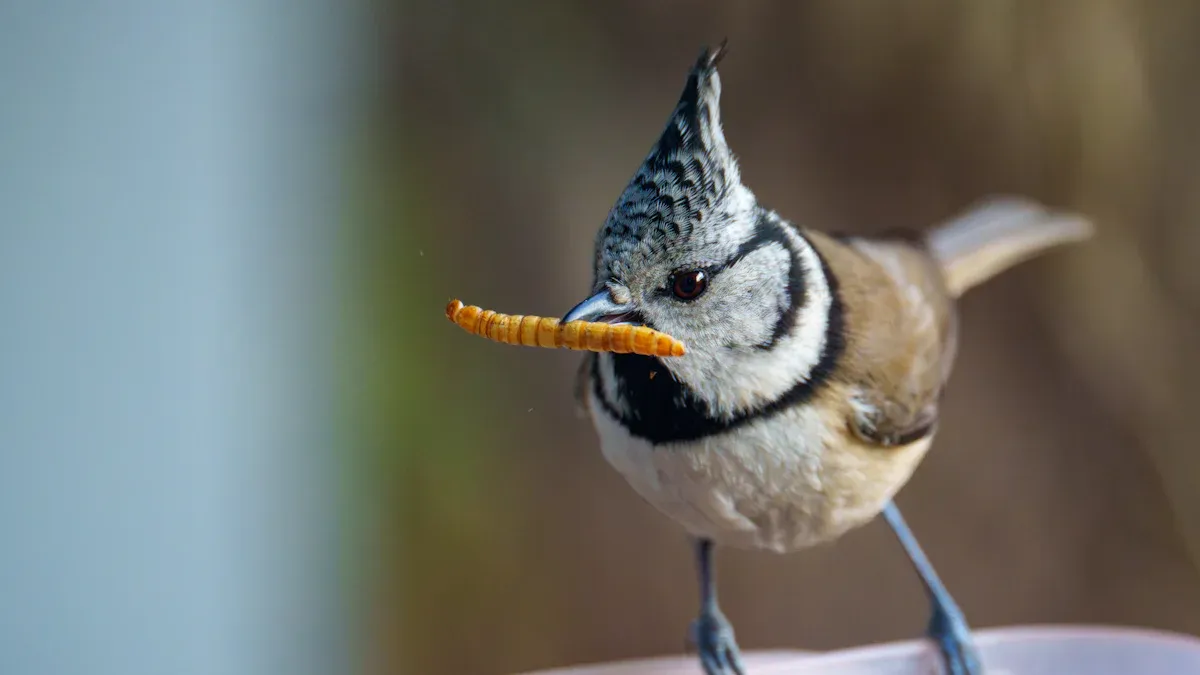
How to Introduce Mealworms to Backyard Birds
Introducing mealworms to backyard birds can feel like a fun experiment. Birds are naturally curious, but they may need a little encouragement to try something new. Start by placing a small handful of mealworms in a shallow dish or tray feeder. Position the feeder in a visible spot where birds already gather. This makes it easier for them to discover the new treat.
For insect-eating birds like bluebirds and robins, both live and dried mealworms work well. Live mealworms wiggle and catch their attention, while dried ones are just as nutritious and easier to handle. To keep mealworms fresh, store them in a cool, dry place. Moldy or decaying mealworms can harm birds, so always check their condition before offering them.
Tip: If birds seem hesitant, sprinkle a few mealworms near their usual feeding area. This helps them associate the new food with a familiar spot.
Tips for Offering Mealworms Safely and Effectively
Feeding mealworms safely requires a few simple steps. First, use a feeder designed for mealworms. For dried mealworms, choose a feeder with drain holes to prevent water buildup. For live mealworms, plug the holes to keep them from escaping. Regularly clean the feeder to remove any leftover mealworms and prevent the spread of diseases.
The VITAL Scientific Expert Panel highlights the importance of managing allergenic risks in food products, including yellow mealworms (Tenebrio molitor). While birds are less likely to experience allergies, these protocols emphasize the need for clean and safe feeding practices. By keeping feeders clean and mealworms fresh, bird enthusiasts can ensure a safe feeding experience.
Here are some quick tips for effective feeding:
- Keep mealworms dry: Moisture can lead to mold, which is harmful to birds.
- Use the right feeder: Choose one with proper drainage or secure live mealworms to prevent escape.
- Clean regularly: Wash feeders weekly to maintain hygiene and bird health.
Note: Feeding mealworms responsibly not only benefits birds but also keeps your backyard environment clean and inviting.
The Importance of a Varied Diet for Birds
While mealworms are a fantastic source of protein and energy, birds need a varied diet to stay healthy. A mix of seeds, fruits, and insects ensures they get all the nutrients they need. Research shows that mealworms contain 55.83% crude protein and essential minerals like calcium, zinc, and magnesium. These nutrients support muscle development, feather growth, and overall vitality.
| Nutrient | Value (per DM basis) |
|---|---|
| Dry Matter (DM) | 94.6% |
| Crude Protein (CP) | 55.83% |
| Crude Fiber (CF) | 25.19% |
| Ash | 4.84% |
| Calcium | 0.21% |
| Phosphorous | 1.06% |
| Magnesium | 0.3% |
| Potassium | 1.12% |
| Sodium | 0.21% |
| Zinc | 138.2 mg/kg |
| Copper | 19.4 mg/kg |
| Manganese | 5.7 mg/kg |
| Iron | 71.50 mg/kg |
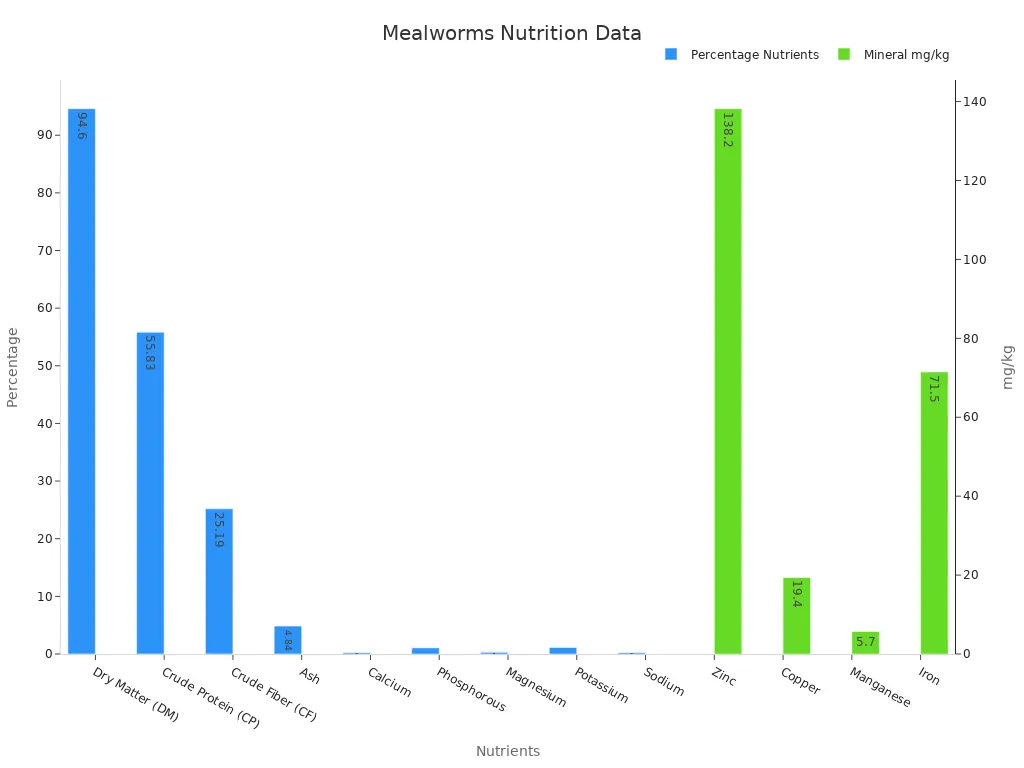
Mealworms on bird feeding habits have shown that birds thrive when their diet includes a variety of foods. For example, during breeding and migration seasons, mealworms provide the extra protein and energy birds need. However, combining them with other food sources ensures balanced nutrition year-round.
Tip: Rotate mealworms with seeds, suet, and fresh fruits to keep birds interested and healthy.
Mealworms offer birds a nutritious boost, supporting their energy and health. Studies show dried mealworms improve nutrient digestibility and reduce nitrogen waste. However, overfeeding can harm growth and weight. Feeding mealworms responsibly, alongside seeds and fruits, ensures balanced nutrition. Try adding mealworms to your bird feeder and watch your feathered friends thrive! 🐦
FAQ
Are dried mealworms as nutritious as live ones?
Yes, dried mealworms retain their protein and fat content. They’re easier to store and handle, making them a convenient option for bird enthusiasts. 🐦
How often should I feed mealworms to birds?
Offer mealworms 2-3 times a week. Birds need variety, so mix them with seeds, fruits, and suet for balanced nutrition.
Can mealworms attract specific bird species?
Absolutely! Robins, bluebirds, and wrens love mealworms. Place them in a visible feeder to attract these insect-loving birds to your yard.


